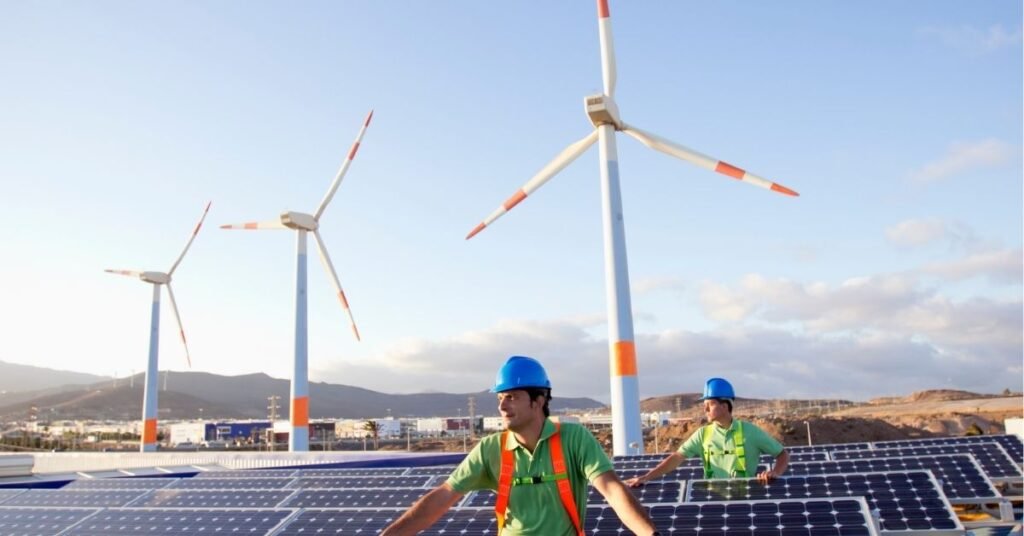In 2025, AI Renewable Energy Optimization is supercharging the U.S. renewable energy revolution, making solar, wind, and grid systems smarter and more efficient than ever.
As the nation races toward net-zero carbon goals, artificial intelligence is proving to be a game-changer, slashing costs, boosting clean energy output, and transforming how power reaches homes and businesses.
From predictive analytics to smart grid management, AI Renewable Energy Optimization is not just powering the grid; it’s powering hope for a sustainable future.
Innovations Driving the Renewable Revolution
AI Renewable Energy Optimization relies on cutting-edge technologies that maximize efficiency at every step. Predictive analytics, powered by machine learning, forecast power demand with unprecedented accuracy, enabling utilities to adjust solar and wind outputs dynamically.
Smart grid balancing uses AI to distribute energy across regions, minimizing waste during low-demand periods. AI-powered energy storage management optimizes battery systems, ensuring surplus renewable energy is stored and deployed efficiently.

For example, Tesla’s AI-driven Megapack batteries can now release stored energy within milliseconds to stabilize grids. These innovations are turning renewables into reliable, scalable solutions for America’s energy needs.
Real-World Impact in the U.S.
Across the U.S., AI Renewable Energy Optimization is being deployed by energy giants, startups, and government initiatives.
In California, Pacific Gas and Electric (PG&E) uses AI to optimize 3.5 million solar panels, increasing output by 15% through real-time panel adjustments.
Startups like Enel X are revolutionizing demand response, using AI to reduce commercial energy use during peak times, saving businesses millions.
The U.S. Department of Energy’s ARPA-E program funds projects like Gridmatic, which uses AI to predict wind power generation with 90% accuracy, cutting costs for utilities in Texas. These efforts showcase how AI is making clean energy more affordable and accessible nationwide.
Benefits for Consumers and Communities
For U.S. consumers, AI Renewable Energy Optimization delivers tangible rewards. Lower energy bills are a direct result, with AI-driven efficiencies reducing utility costs by up to 20%, according to a 2025 BloombergNEF report. Reduced carbon emissions are another win.
AI-optimized grids cut greenhouse gas output by 10-15% compared to traditional systems. Consumers also enjoy more reliable clean energy, as AI minimizes outages by predicting and addressing grid failures before they occur.
In rural areas, where grid access can be spotty, AI-enhanced microgrids ensure consistent power, improving quality of life and economic opportunities.
Advancing U.S. Climate Goals
AI Renewable Energy Optimization is a critical ally in the fight against climate change. By maximizing renewable output, AI helps the U.S. edge closer to its 2035 net-zero electricity target.
The Biden administration’s goal of 100% clean electricity relies heavily on scaling renewables, and AI is making this feasible.
For instance, AI-driven wind farms in Iowa now generate 20% more power annually by optimizing turbine angles in real-time.
The Environmental Protection Agency estimates that widespread AI adoption in energy could reduce U.S. carbon emissions by 600 million metric tons by 2030, equivalent to removing 130 million cars from the road. This technology is a cornerstone of America’s climate strategy.
Challenges and Risks to Address
Despite its promise, AI Renewable Energy Optimization faces hurdles. High implementation costs, often millions for grid upgrades, pose barriers, especially for smaller utilities.
Reliance on accurate data is critical; faulty inputs can lead to inefficiencies or grid failures. Cybersecurity is a growing concern, as AI-driven systems are prime targets for hackers, with 2024 seeing a 30% rise in energy sector cyberattacks.
Public skepticism about over-dependence on AI also lingers, with some fearing job losses in traditional energy roles. Addressing these risks requires robust investment, rigorous data protocols, and enhanced security measures.

Expert Insights: Can AI Save the Planet?
Experts are cautiously optimistic about AI Renewable Energy Optimization. “AI is a force multiplier for renewables, but it’s not a silver bullet,” says Dr. Amory Lovins, co-founder of the Rocky Mountain Institute.
“Strong policies like tax incentives and emissions caps are essential to amplify its impact.” Analysts predict that by 2030, 60% of U.S. utilities will adopt AI optimization, but scaling requires addressing equity concerns, as underserved regions often lack access to advanced tech.
Dr. Jennifer Stokes, an energy policy expert, emphasizes that “AI can cut emissions significantly, but only if paired with infrastructure investment and workforce retraining.” The consensus is clear: AI is transformative, but systemic support is key.
The Future of U.S. Energy
Looking ahead, AI Renewable Energy Optimization is poised to transform renewables from a supplementary source to the backbone of the U.S. power grid.
By 2035, experts forecast that AI could power 80% of America’s electricity through optimized clean energy systems.
As costs drop and technology advances, AI will make renewables not just sustainable but economically unbeatable.
However, success hinges on balancing innovation with responsibility—securing grids, ensuring equitable access, and pairing AI with bold climate policies.
With AI Renewable Energy Optimization leading the charge, the U.S. is on track to build a cleaner, smarter, and more resilient energy future that could indeed help save the planet.
3. Output Analysis:
— alex-00110111 (@zerocopy01) August 27, 2025
Use AI and machine learning to analyze the results.
Visualize the quantum pathways with the Quantum Tunnel Mapper.
4. Energy Optimization:
Recycle energy from collisions to power the system.
Use renewable sources for sustainability.
Also Read: Game-Changing AI Education Learning Personalization Excels

Abdul Basit is a US-based tech writer who covers Apple innovations, Tesla’s EV growth, AI breakthroughs, smartphone trends, and app reviews for global readers.
